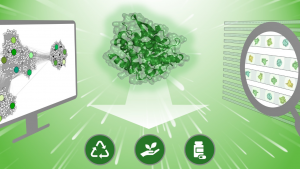Scientists developed a new method for discovering more efficient enzymes
Nature cannot do without enzymes – proteins that speed up chemical reactions in all living organisms. For example, we owe our beer and wine to enzymes; we wouldn’t enjoy hard cheeses and, in principle, wouldn’t do laundry without them. But people also use enzymes in biomedicine, industry, and environmental protection. Unfortunately, relatively few enzymes perform optimally, so scientists have been working for decades on searching for more efficient enzymes. In doing so, they keep running into a fundamental question: Is it better to modify existing enzymes through protein engineering or to search for new ones in nature’s vast diversity?
Researchers from the Loschmidt Laboratories at RECETOX, Faculty of Science, Masaryk University and the International Clinical Research Center (ICRC), in collaboration with colleagues from ETH Zurich and the University of Greifswald, decided to go down the route of searching for new enzymes. They published the results of their six-year research project in the international prestigious journal Chem Catalysis. Their aim was to find more efficient variants of an enzyme family that can degrade halogenated hydrocarbons polluting the environment. The search began in genomic databases, which currently contain hundreds of millions of gene sequences that encode previously unknown proteins. Using the in-house web tool EnzymeMiner, they were able to select the most promising candidates from this plethora of sequences. “You could compare it to finding needles in a haystack. With EnzymeMiner we can distinguish the needle from the straw very well. However, in the next step we need to find out if the selected needles are sharp enough – this means to experimentally verify that the selected enzymes are fast enough,” said Michal Vašina, the first author of the study.
Therefore, the researchers then prepared these selected candidates in the laboratory and studied their properties using two microfluidic platforms – modern technologies that can handle miniature sample volumes and save time. The first platform, MicroPEX, was used by the researchers to systematically characterize enzymatic reaction rates, while the second platform, KinMAP, gave them insight into the actual mechanism of enzymatic reactions. “The savings in time and money are tremendous. Thanks to this method, we can measure the same amount of data in a single week that would take months to obtain with conventional technologies,” said the microfluidic expert Zbyněk Prokop.
Coming back to the question from the beginning of the article, whether it is better to discover or engineer new enzymes, this scientific study gives a clear answer. Historically, the first enzymes degrading halogenated hydrocarbons were identified more than 30 years ago, while protein engineering has been used for their modification for 25 years. During this time, the properties of twenty-five discovered and more than one hundred modified enzyme variants have been described. When comparing the data obtained, the researchers found that the newly obtained enzymes had better properties than any previously discovered or modified enzyme from the same family.
So how to get more efficient enzymes? Based on their experience, the scientists in the Loschmidt Laboratories answer: “Let’s not underestimate nature. Thanks to its diversity, it has an arsenal of effective enzymes just waiting to be discovered!”
Publication:
https://doi.org/10.1016/j.checat.2022.09.011
The synergy of advanced bioinformatics and microfluidics helps to find efficient enzymes for recy-cling chemical synthesis intermediates, degrading environmental pollutants, or preparing active pharmaceutical ingredients.


